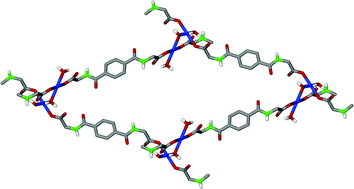Interpenetrated networks from a novel nanometer-sized pseudopeptidic ligand, bridging water, and transition metal ions with cds topology†
Abstract
The combination of a new pseudopeptidic

* Corresponding authors
a Dipartimento di Chimica Generale, Universitá di Pavia, Via Taramelli 12, Pavia, Italy
b
Department of Chemistry, University of Ioannina, Ioannina, Greece
E-mail:
iplakatu@cc.uoi.gr
c Department of Physics, University of Ioannina, Ioannina, Greece
The combination of a new pseudopeptidic

 Please wait while we load your content...
Something went wrong. Try again?
Please wait while we load your content...
Something went wrong. Try again?
G. E. Kostakis, L. Casella, N. Hadjiliadis, E. Monzani, N. Kourkoumelis and J. C. Plakatouras, Chem. Commun., 2005, 3859 DOI: 10.1039/B502788H
To request permission to reproduce material from this article, please go to the Copyright Clearance Center request page.
If you are an author contributing to an RSC publication, you do not need to request permission provided correct acknowledgement is given.
If you are the author of this article, you do not need to request permission to reproduce figures and diagrams provided correct acknowledgement is given. If you want to reproduce the whole article in a third-party publication (excluding your thesis/dissertation for which permission is not required) please go to the Copyright Clearance Center request page.
Read more about how to correctly acknowledge RSC content.
 Fetching data from CrossRef.
Fetching data from CrossRef.
This may take some time to load.
Loading related content
